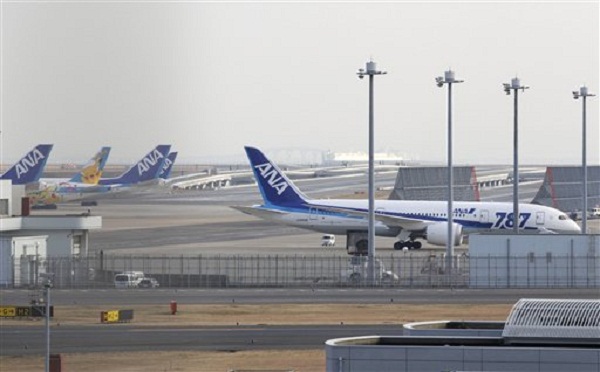
All Nippon Airways planes including a Boeing 787, right, are parked at Haneda Airport in Tokyo Wednesday afternoon, Jan. 16, 2013. ANA and Japan Airlines Wednesday took half the global Dreamliner fleet out of service on safety grounds after an emergency landing by an ANA flight brought new trouble for Boeing’s next-generation plane. AP/SHIZUO KAMBAYASHI
TOKYO—Japan’s two biggest airlines Wednesday took half the global Dreamliner fleet out of service on safety grounds after an emergency landing by an ANA flight brought new trouble for Boeing’s next-generation plane.
But carriers including All Nippon Airways insisted that the highly fuel-efficient 787 Dreamliner was still a safe bet, despite several incidents that have prompted investigations by US and other aviation regulators.
ANA—the world’s first carrier to receive the Dreamliner from Boeing after years of delays—said smoke caused possibly by a faulty battery forced the pilots to land the passenger plane in Takamatsu, southwestern Japan.
The airline said cockpit instruments had detected the smoke inside a forward electrical compartment, and Japanese Transport Minister Akihiro Ota said it was a “serious incident that could have led to a serious accident.”
One of the 129 passengers on the Tokyo-bound domestic flight was quoted by broadcaster NHK as saying he “smelled something strange” after take-off and feared the plane was going to crash.
Nobody was seriously injured when the passengers and eight crew members evacuated via emergency chutes.
ANA and its rival Japan Airlines (JAL)—among Boeing’s biggest customers for the Dreamliner—said they would ground their entire 787 fleets through Thursday at least, pending safety checks.
ANA has 17 Dreamliners in its fleet and JAL has seven—half the total of 49 planes that are in operation worldwide. Nearly 850 are on Boeing’s order books.
The Dreamliner is seen as an aviation milestone with its use of lightweight composite materials and electronics, instead of aluminium and hydraulics, and airlines have embraced the plane at a time of sky-high fuel costs.
But a week of mishaps leading up to the forced landing in Japan has generated unwelcome headlines for Boeing—which says it has “complete confidence” in the plane and is pledging to work with its customers and regulatory agencies.
Along with fuel leaks and a cracked cockpit window involving the 787 over recent days, there was a battery fire and smoke on an empty JAL-operated Dreamliner on the ground in the US city of Boston last week.
JAL said that involved the battery used for the Dreamliner’s auxiliary power unit, located at the rear of the plane. Wednesday’s incident involved the forward battery for the main power unit, ANA said.
“The aircraft made the emergency landing because of the smoke problem” after the battery malfunction, ANA vice president Osamu Watanabe told a news conference.
“We’ve only been using these aircraft for a year and we don’t have enough information about the cause. That’s why we decided to stop using these planes for the moment,” he said.
Both the US Federal Aviation Administration (FAA) and Japan’s transport ministry broadened existing probes into the Dreamliner to encompass the latest incident. Authorities in India said they were starting their own investigation.
Shukor Yusof, aviation analyst with Standard and Poor’s Equity Research in Singapore, said Boeing would suffer a “huge” blow if the FAA orders structural changes to the Dreamliner’s design, “but we are nowhere near that stage.”
Noting teething troubles with Airbus’s A380 superjumbo, he said technical glitches were not unusual with new planes.
But Yusof described the problems as “very embarrassing” for Boeing and said: “This is an aircraft that was delayed for nearly three years, so potential customers will naturally question the safety part of the aircraft.”
Despite the grounding, ANA said it stood by billions of dollars committed to future 787 orders.
The Dreamliner received backing too from other carriers that have bet big on the project, with British Airways, Singapore Airlines, Australia’s Qantas and Korean Air all affirming pending orders.
Public confidence in the Dreamliner may have been dented, however, after production setbacks among Boeing’s large array of subcontractors—many of them Japanese—delayed delivery of the first plane to ANA by three years to 2011.
“This morning, I heard the news and I got a bit scared. I checked that my flight wasn’t on a Boeing 787,” Tomohiko Maruyama, who was waiting to board his ANA flight at Tokyo’s Haneda airport, told AFP.